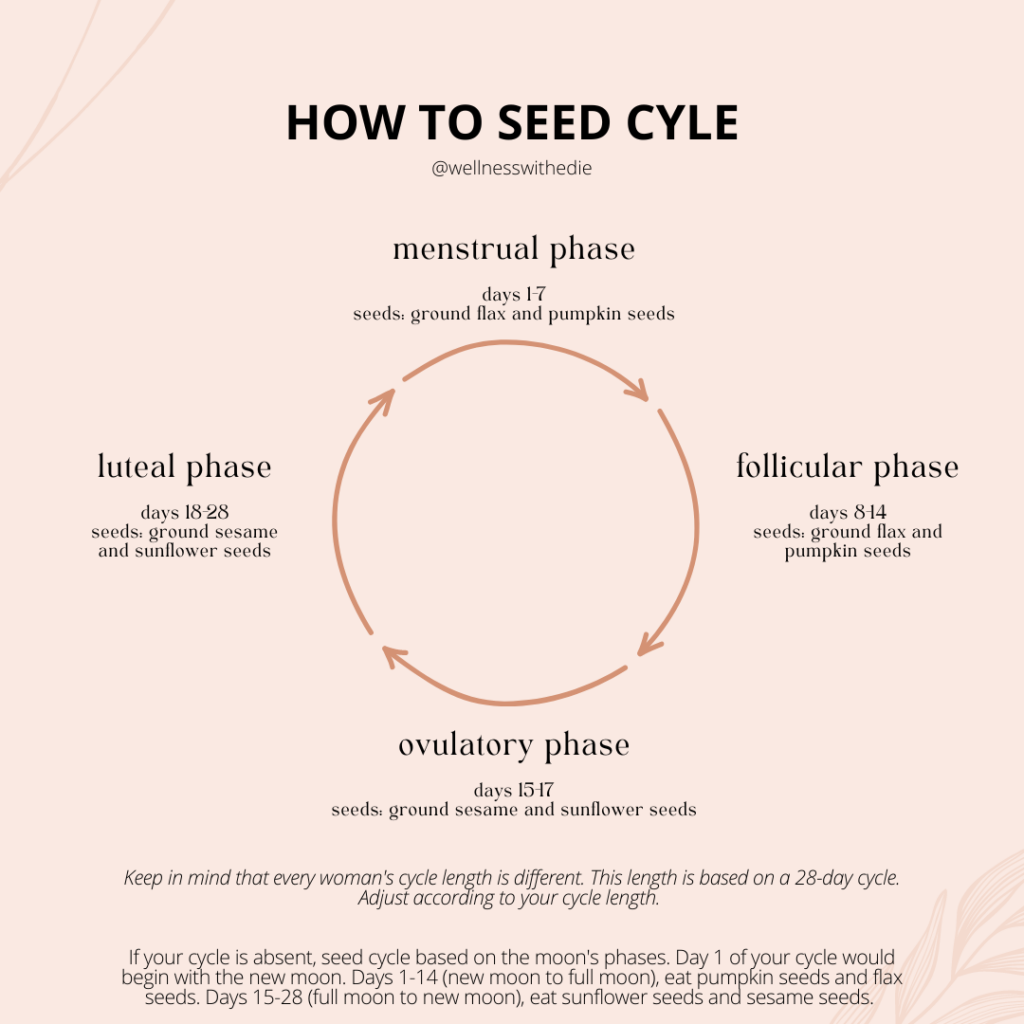Tired of dealing with unpredictable periods, mood swings, and other pesky symptoms of hormone imbalances? Look no further than seed cycling—a natural and gentle way to balance your hormones. By incorporating specific seeds into your diet (at certain times in your menstrual cycle), seed cycling can promote healthy levels of estrogen and progesterone. In turn, leading to improved fertility, menstrual regularity, and overall well-being. In this guide, you’ll learn all about seed cycling to balance hormones, which seeds to use, and how to incorporate this practice into your daily routine. Get ready to cycle your way to hormonal harmony!

What is seed cycling?
Seed cycling is a natural method of hormone balance. It involves eating specific types of seeds throughout your menstrual cycle. This practice is gaining popularity among women who seek to improve their hormone health and fertility. Small studies show that seed cycling can support women’s hormonal health by promoting balanced estrogen and progesterone levels throughout the menstrual cycle. Why is this important? Because imbalances in these hormones can lead to a variety of symptoms—irregular periods (PCOS), mood swings, and infertility.
Eating seeds to balance hormones
Seed cycling involves two phases, and each lasts around two weeks. During the first phase of the menstrual cycle—the follicular phase—women consume a mixture of pumpkin and flax seeds. These are high in lignans. Lignans are plant compounds that can bind to excess estrogen in the body and remove them via the digestive tract (this is particularly helpful during the first phase of the menstrual cycle!). During the second phase—the luteal phase—women consume a mixture of sesame and sunflower seeds. These are high in vitamin E and other nutrients to support progesterone production.

Can seed cycling reduce anovulatory cycles?
Preliminary data says, yes. But what is an anovulatory cycle? Essentially, this is when an egg is not released from the ovary during a menstrual cycle. While this can happen from time to time, if it happens on a consistent basis, it is typically a telltale sign of PCOS, being underweight or overweight, exercising excessively, or experiencing significant stress. In other words, anovulatory cycles indicate a hormonal imbalance. Along with seed cycling, my Master Your Menstrual Cycle eBook can help regulate ovulation!
Flax seeds support ovulation
All hail the mighty flax seed. In an effort to encourage ovulation, one small study had women eat flax seeds for three cycles. Afterward, researchers compared their previous cycles (without flax seeds) to their cycles with flax seeds. They found there were no anovulatory cycles after incorporating flax. This means that none of the women skipped ovulation while consuming flax seeds! This is very promising data when it comes to seed cycling to balance hormones.
Who should seed cycle?
Seed cycling can support a woman at any stage in her life—from teen years all the way through menopause. However, it’s particularly beneficial for women who plan to stop hormonal birth control, couples who want to improve their chances of conceiving, or those who experience menstrual cycle conditions: intense PMS, irregular cycles, and anovulatory cycles. Seed cycling is a natural yet effective way to help women regain their cycle, too. Improving hormonal health is made possible via a nutrient-dense diet, blood sugar balance, and seed cycling.

research On seed cycling
Along with the aforementioned data on flax seeds and anovulatory cycles, additional research is promising. This study shows that women who consume a mixture of flaxseed and sesame seeds (daily for three months) experience fewer hot flashes. Furthermore, more research shows that consuming sunflower seeds (daily for six weeks) increases progesterone levels in women with irregular periods. While these studies show favorable results, more research is needed to fully understand seed cycling’s effects on women’s hormonal health. However, the anecdotal data speaks volumes: many women report experiencing improved menstrual cycles, reduced symptoms of PMS, and increased fertility after implementing seed cycling into their diet.
Disclaimer: It’s important to note that seed cycling is not a substitute for medical treatment and should be used in conjunction with other health-promoting practices such as regular exercise, a balanced diet, and stress management.
Seed Cycling schedule
To begin seed cycling, figure out where you’re at in your menstrual cycle. Are you in your follicular phase (you’re currently on your period or your period ended less than 10 days ago)? Or, are you in your luteal phase (you’ve just ovulated or you ovulated recently)? Depending on which phase you’re in, skip below to see which seeds you should start incorporating. If your cycle is irregular, don’t fret. You can still seed cycle effectively. More on this at the bottom of the article.

1. FOLLICULAR PHASE
The first 14 (or so) days of your menstrual cycle is the follicular phase. During this phase, you eat two tablespoons of ground pumpkin and flaxseeds.
When: Days 1-14 of your cycle. During this phase, you need a balanced amount of estrogen to build the uterine lining.
What Seeds: Pumpkin and flax. Pumpkin seeds are rich in zinc, which aids in progesterone production and supports healthy testosterone levels. They’re also rich in antioxidants, which help protect your ovaries, eggs, and reproductive system as a whole. Flax seeds can aid in estrogen release, meaning they bind excess estrogen and help eliminate it to support ideal estrogen levels. Both flax and pumpkin seeds are rich in omega-3 fats, which encourage uterine blood flow and maintain healthy cell membranes.
2. LUTEAL PHASE
The following 14 (or so) days is the luteal phase. When your hormone levels are balanced, estrogen rises during the first half of your cycle whereas progesterone levels rise (while estrogen levels slowly decline) during the second half of your cycle.
When: Days 15-28 of your cycle—during this phase, the corpus luteum starts to release progesterone, which is a sex hormone that helps thicken the uterine lining and prepare it for implantation.
What Seeds: Sesame and sunflower. Sesame seeds are rich in zinc, which aids in progesterone production. They also contain lignans, which help block excess estrogen, and they have a slew of other benefits, including the ability to lower inflammation. Sunflower seeds contain selenium, which helps improve liver function and remove excess estrogen. They also contain vitamin E, which stimulates progesterone production.

Can you seed cycle if you’re on birth control?
Absolutely. Whether you’re on birth control or have an irregular / absent cycle, seed cycling can support hormone health. To keep things simple, follow the phases of the moon as a general guideline. In this case, day 1 of your cycle would begin with the new moon. Days 1-14 (new moon to full moon), eat pumpkin seeds and flax seeds. Days 15-28 (full moon to new moon), eat sunflower seeds and sesame seeds. Whether you have a regular cycle or not, about three months of cycling is said to be enough to begin seeing the benefits. Remember, consistency is key.
easy ways to add seeds to your diet
When it comes to seed cycling, there are many delicious, creative, and simple ways to add these nutrients to your diet. I love making this chia pudding for breakfast and adding my seeds directly to the mixture. That said, you can add your seeds to smoothies, toss them in yogurt bowls, sprinkle them on avocado toast, add texture to soup, etc. You can also make energy bites! The sky’s the limit.
Where to buy seeds for seed cycling
My friends at Funk It Wellness will ship them directly to you! No need to grind your own seeds at home.
How long it takes for seed cycling to work
If you seed cycle every day for at least three months—in conjunction with a nutritious diet, balanced blood sugar, and prioritizing quality sleep, you should notice a difference in about three cycles (three months). Additionally, you may want to incorporate hormone-balancing supplements to further support your well-being goals.

This article is for informational purposes only. It is not, nor is it intended to be, a substitute for professional medical advice, diagnosis, or treatment and we recommend that you always consult with your healthcare provider.



Leave a Reply